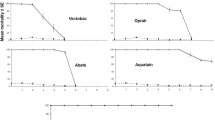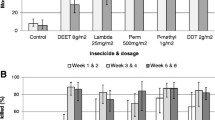Abstract
To combat mosquitoes and the public health hazards they present, spraying chemical adulticides is an efficient and timely control method for immediate reduction of adult populations. With the growing consciousness of environmental and public health concerns, effective mosquito control means not only maximizing the effectiveness (in terms of mosquito mortality rates) of the pesticide application, but also minimizing the unintended effects (health hazard and environmental pollution). A series of experiments was carried out to assess the efficacy and deposition of ultra-low volume (ULV) sprays on adult mosquitoes which included the influence of chemical type, spray volume, spray concentration, droplet size, and deposit location (where the droplets land on the mosquito). A modified Potter Tower was used to apply an extremely fine spray (volume median diameter ∼20 μm) on caged adult mosquitoes (Culex quinquefasciatus). Reslin® (50 g/L bioresmethrin) was diluted in either water or D-C-Tron® plus spray oil (782 g/L paraffinic petroleum oil), Twilight® (89 g/L phenothrin) was diluted in D-C-Tron®, and the mosquito mortality was assessed 24 h after spraying. A fluorescent tracer was added to the spray mixture to determine the amount of spray on mosquitoes. A fluorescent microscope was also used to view the deposit of droplets on mosquitoes. It was found that droplet retention and mortality were reduced with the larger droplet sizes. Large water-based droplets tend to bounce off adult mosquitoes. There is a tendency for droplets approximately 20 μm in size to be retained on the fine hairs on the mosquito. The largest spray deposit was found on the adult mosquito wings and the lowest deposit on the head. Mortality was higher for formulations diluted with oil compared to those diluted with water. ULV applications with ultra-fine sprays (VMD 20 μm) and oil-based products resulted in maximum target efficacy under laboratory conditions, at minimum cost, and with the minimum amount of chemical adulticides.











Similar content being viewed by others
References
Amoo AOJ, Xue RD, Qualls WA, Quinn BP, Bernier UR (2008) Residual efficacy of field-applied permethrin, d-phenothrin, and resmethrin on plant foliage against adult mosquitoes. J Am Mosq Control Assoc 24(4):543–549
Anees AM (2008) Larvicidal activity of Ocimum sanctum Linn. (Labiatae) against Aedes aegypti (L.) and Culex quinquefasciatus (Say). Parasitol Res 103(6):1451–1453
Antwi FB, Peterson RKD (2009) Toxicity of δ-phenothrin and resmethrin to non-target insects. Pest Manag Sci 63:300–305
Antwi FB, Shama LM, Peterson RKD (2008) Risk assessments for the insect repellents DEET and picaridin. Regul Toxicol Pharmacol 51:31–36
Arredondo-Jimenez JI, Rivero NE (2006) Space treatments of insecticide for control of dengue virus vector Aedes aegypti in southern Mexico. I. Baseline penetration trials in open field and houses. J Am Mosq Control Assoc 22:301–305
Bache DH (1994) The trapping of spray droplets by insects. Pestic Sci 41:351–357
Bonds JA, Greer M, Coughlin J, Patel V (2010) Caged mosquito bioassay: studies on cage exposure pathways, effects of mesh on pesticide filtration, and mosquito containment. J Am Mosq Control Assoc 26:50–56
Campos J, Andrade CFS (2003) Larval susceptibility of Aedes aegypti and Culex quinquefasciatus populations to chemical insecticides. Rev Saude Publica 37(4):523–527
Chaskopoulou A, Nguyen S, Pereira RM, Scharf ME, Koehler PG (2009) Toxicities of 31 volatile low molecular weight compounds against Aedes aegypti and Culex quinquefasciatus. J Med Entomol 46:328–334
Cooperband MF, Golden FV, Clark GG, Jany W, Allan SA (2010) Prallethrin-induced excitation increases contact between sprayed ultralow volume droplets and flying mosquitoes (Diptera: Culicidae) in a wind tunnel. J Med Entomol 47:1099–1106
Dukes JC, Hallmon CF, Shaffer KR, Hester PG (1990) Effects of pressure and flow rate on Cythion droplet size produced by three different ground ULV aerosol generators. J Am Mosq Control Assoc 6:279–282
Fradin MS, Day JF (2002) Comparative efficacy of insect repellents against mosquito bites. N Engl J Med 347:13–18
Haile DG, Mount GA, Pierce NW (1982) Effect of droplet size of malathion aerosols on kill of caged adult mosquitoes. Mosq News
Kain KC, MacPherson DW, Kelton T, Keystone JS, Mendelson J, MacLean JD (2001) Malaria deaths in visitors to Canada and in Canadian travellers: a case series. Can Med Assoc J 164:654–659
Kraiss H, Cullen EM (2008) Efficacy and nontarget effects of reduced-risk insecticides on Aphis glycines (Hemiptera: Aphididae) and its biological control agent Harmonia axyridis (Coleoptera: Coccinellidae). J Econ Entomol 101:391–398
Lee HL, Jr GE, Khadri MS et al (1996) Ultralow volume application of Bacillus thuringiensis ssp. israelensis for the control of mosquitoes. J Am Mosq Control Assoc 12(4):651–655
Milam CD, Farris JL, Wilhide JD (2000) Evaluating mosquito control pesticides for effect on target and nontarget organisms. Arch Environ Contam Toxicol 39:324–328
Mount GA (1998) A critical review of ultralow-volume aerosols of insecticide applied with vehicle-mounted generators for adult mosquito control. J Am Mosq Control Assoc 14:305–334
Mount GA, Biery TL, Haile DG (1996) A review of ultralow-volume aerial sprays of insecticide for mosquito control. J Am Mosq Control Assoc 12:601–608
Nagy K, Rácz G, Matsumoto T et al (2014) Evaluation of the genotoxicity of the pyrethroid insecticide phenothrin. Mutat Res Genet Toxicol Environ Mutagen 770(8):1–5
Preftakes CJ, Schleier JJ, Peterson RKD (2011) Bystander exposure to ultra-low-volume insecticide applications used for adult mosquito management. Int J Environ Res Public Health 8(6):2142–2152
Pridgeon JW, Meepagala KM, Becnel JJ, Clark GG, Pereira RM, Linthicum KJ (2007) Structure-activity relationships of 33 piperidines as toxicants against female adults of Aedes aegypti (Diptera: Culicidae). J Med Entomol 44:263–269
Pridgeon JW, Pereira RM, Becnel JJ, Allan SA, Clark GG, Linthicum KJ (2008) Susceptibility of Aedes aegypti, Culex quinquefasciatus Say, and Anopheles quadrimaculatus Say to 19 pesticides with different modes of action. J Med Entomol 45:82–87
Pridgeon JW, Becnel JJ, Clark GG, Linthicum KJ (2009) A high-throughput screening method to identify potential pesticides for mosquito control. J Med Entomol 46:335–341
Rawlins SC (1998) Spatial distribution of insecticide resistance in Caribbean populations of Aedes aegypti and its significance. Pan Am J Public Health 4(4):243–251
Reddy MR, Spielman A, Lepore TJ, Henley D, Kiszewski AE, Reiter P (2006) Efficacy of resmethrin aerosols applied from the road for suppressing Culex vectors of West Nile virus. Vector Borne Zoonotic Dis 2:117–127
Somboon P, Prapanthadara L-a, Suwonkerd W (2003) Insecticide susceptibility tests of Anopheles minimus sl, Aedes aegypti, Aedes albopictus, and Culex quinquefasciatus in northern Thailand. Southeast Asian J Trop Med Public Health 34:87–93
Thatheyus AJ, Selvam ADG (2013) Synthetic pyrethroids: toxicity and biodegradation. Appl Ecol Environ Sci 1:33–36
Thomas DM, Urena B (2001) A model describing the evolution of West Nile-like encephalitis in New York City. Math Comput Model 34:771–781
Acknowledgments
The first author is grateful to the National Natural Science Foundation of China (NSFC 31371963), Natural Science Foundation of Jiangsu Province (BK20130965), and the Priority Academic Program Development of Jiangsu Higher Education Institutions (PAPD) for providing financial assistance. This research was part of an Australian Research Council (ARC) Linkage project (LP0669659) with funding provided by ARC, Pacific Biologics/Clarke Mosquito Control, Logan City Council, Gold Coast City Council, and Sunshine Coast Regional Council.
Author information
Authors and Affiliations
Corresponding author
Additional information
Responsible editor: Philippe Garrigues
Electronic supplementary material
Below is the link to the electronic supplementary material.
ESM 1
(pdf 10503 kb)
Rights and permissions
About this article
Cite this article
Zhang, H., Dorr, G.J. & Hewitt, A.J. Retention and efficacy of ultra-low volume pesticide applications on Culex quinquefasciatus (Diptera: Culicidae). Environ Sci Pollut Res 22, 16492–16501 (2015). https://doi.org/10.1007/s11356-015-5480-9
Received:
Accepted:
Published:
Issue Date:
DOI: https://doi.org/10.1007/s11356-015-5480-9




